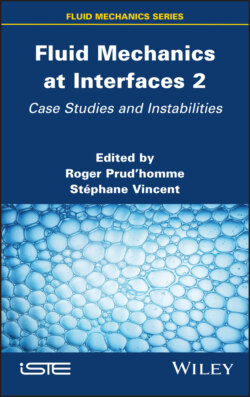Fluid Mechanics at Interfaces 2

Реклама. ООО «ЛитРес», ИНН: 7719571260.
Оглавление
Группа авторов. Fluid Mechanics at Interfaces 2
Table of Contents
List of Tables
List of Illustrations
Guide
Pages
Fluid Mechanics at Interfaces 2
Preface
1. Turbulent Channel Flow to Reτ = 590 in Discrete Mechanics
1.1. Introduction
1.2. Discrete mechanics formulation
1.3. Turbulent flow in channel. 1.3.1. Analysis of a turbulent flow in a planar channel
1.3.2. Model of the turbulence in discrete mechanics
1.3.3. Application to a turbulent flow in a channel with Reτ = 590
1.4. Conclusion
1.5. References
2. Atomization in an Acceleration Field1
List of symbols
2.1. Introduction. 2.1.1. Two classic instabilities
2.1.2. Atomization
2.2. Generation of droplets through vibrations normal to the liquid layer
2.3. Rayleigh–Taylor instability at the crest of an axial wave
2.3.1. Size distribution of the drops
2.4. Recent work
2.5. Conclusion
2.6. References
3. Numerical Simulation of Pipes with an Abrupt Contraction Using OpenFOAM
3.1. Introduction
3.2. Modeling an abrupt contraction in a pipe. 3.2.1. Euler equations
3.2.2. Stability of the solver
3.2.3. Introducing the model
3.2.4. Boundary and initial conditions
3.3. Numerical results
3.3.1. Results with the boundary and initial conditions I. 3.3.1.1. Variation in mean flow rate and mean enthalpy
3.3.1.2. Variation in mean mass
3.3.1.3. Glyphs and contour line
3.3.1.4. Isosurfaces
3.3.2. Results with the boundary and initial conditions II. 3.3.2.1. Mesh for a quarter of the domain
3.3.2.2. Variations in the mean flow rate
3.3.2.3. The vector field and isosurfaces
3.4. Conclusion and future prospects
3.5. References
4. Vaporization of an Equivalent Pastille
List of symbols
4.1. Introduction
4.2. Equations for the problem
4.3. Linear analysis of the liquid phase. 4.3.1. The function G (u, PeL)
4.3.2. Solution
4.3.3. The depth to which heat penetrates
4.4. Some results
4.4.1. Thermal perturbations
4.4.2. Response factor
4.5. Conclusion
4.6. References
5. Thermal Field of a Continuously-Fed Drop Subjected to HF Perturbations
List of symbols
5.1. Drops in a liquid-propellant rocket engine
5.2. A continuously fed droplet
5.3. Equations of the problem. 5.3.1. Equations for the gaseous phase
5.3.2. Equations for the liquid phase
5.4. Linearized equations
5.5. Linearized equations for small harmonic perturbations
5.6. Thermal field in the drop when neglecting internal convection
5.7. Conclusion
5.8. Appendix 1: Coefficients that come into play in linearized equations
5.9. Appendix 2: Solving the thermal equation
5.10. Appendix 3: The case of the equivalent pastille
5.11. Appendix 4: 2D representation for the spherical drop
5.12. References
6. Study of the Three-Dimensional and Non-Stationary Flow in a Rotor of the Savonius Wind Turbine
6.1. Introduction
6.2. Mathematical modeling of the problem. 6.2.1. Presentation of a physical model
6.2.2. Simplifying hypotheses
6.3. Numerical resolution
6.3.1. Presentation of meshes
6.3.2. Spatial discretization
6.3.3. Temporal discretization
6.3.4. Stability condition for the scheme
6.3.5. Initial conditions
6.3.6. Boundary conditions
6.4. Validation of the results
6.5. Results and discussion. 6.5.1. Influence of the advance parameter
6.5.2. Influence of the angular position of the blades
6.6. Conclusion
6.7. Acknowledgments
6.8. References
List of Authors
Index
A
C, D
E
F, H
I, L, N
O, P, R
S, T, V
Summary of Volume 1
WILEY END USER LICENSE AGREEMENT
Отрывок из книги
Case Studies and Instabilities
.....
Chapters 4 (R. Prud’homme and K. Anani) and 5 (R. Prud’homme, K. Anani and M.N. Hounkonnou) study the evaporation of droplets subject to HF (high-frequency) perturbations, a possible cause of instabilities in injection engines. The Heidmann model, which replaces the droplets in motion in the combustion chamber by a single continuously fed droplet, is complexified by taking into account the finite conduction heat transfer phenomenon. This accentuates the damping of oscillations in the evaporation rate. We study the temperature field within the drop, as well as the response factor of a spherical drop to the high-frequency pressure field created by the engine. A pastille-shaped model of the drop is used, replacing the spherical drop, which makes it possible to go further with linearized calculations.
Finally, Chapter 6 (F. Raveloson, D. Tomboravo and R. Vony) presents the study of the interface, which is the surface of rotor blades in a Savonius wind turbine. A non-stationary and 3D flow is studied.
.....